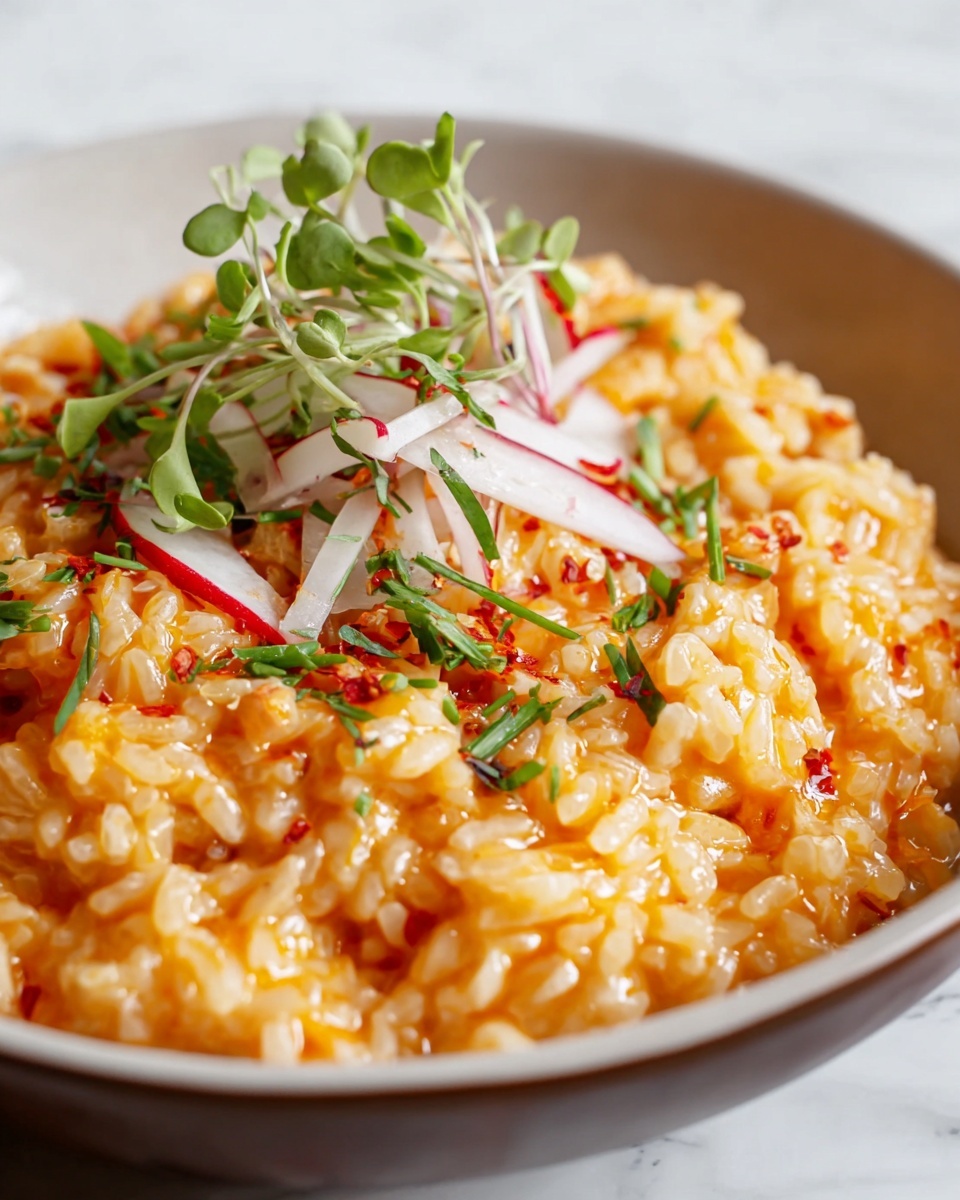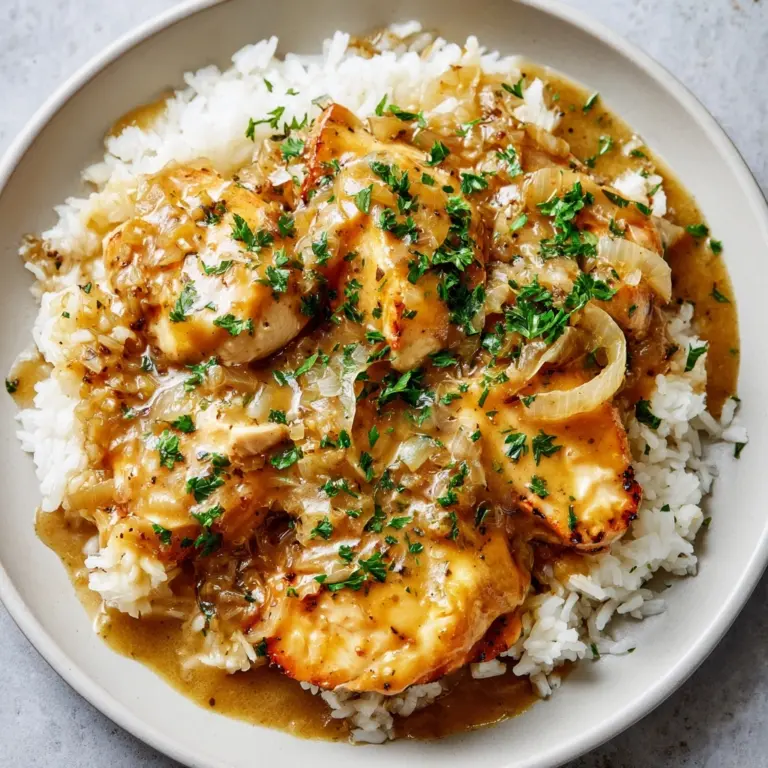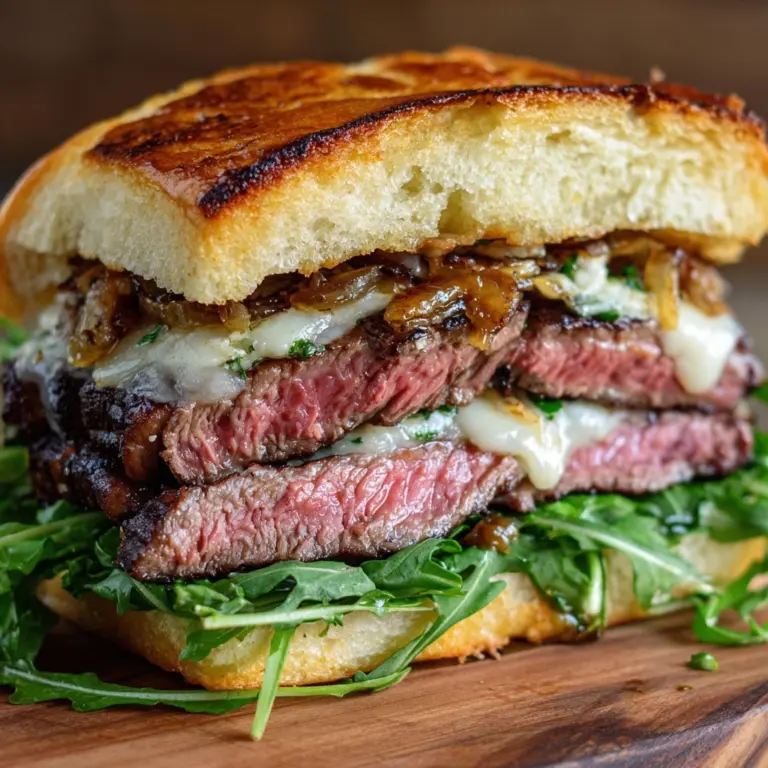If you’re craving a dish that delivers a stunning blend of creamy comfort and bold Korean-inspired heat, this Cheesy Gochujang Risotto Recipe is about to become your new kitchen hero. Picture that luscious, velvety risotto enriched with Parmesan and mozzarella cheeses, all perfectly balanced by the vibrant, spicy kick of gochujang. It’s a celebration of flavors and textures that’s surprisingly easy to whip up but impressively sophisticated, making every bite feel like a warm hug with a little fire.
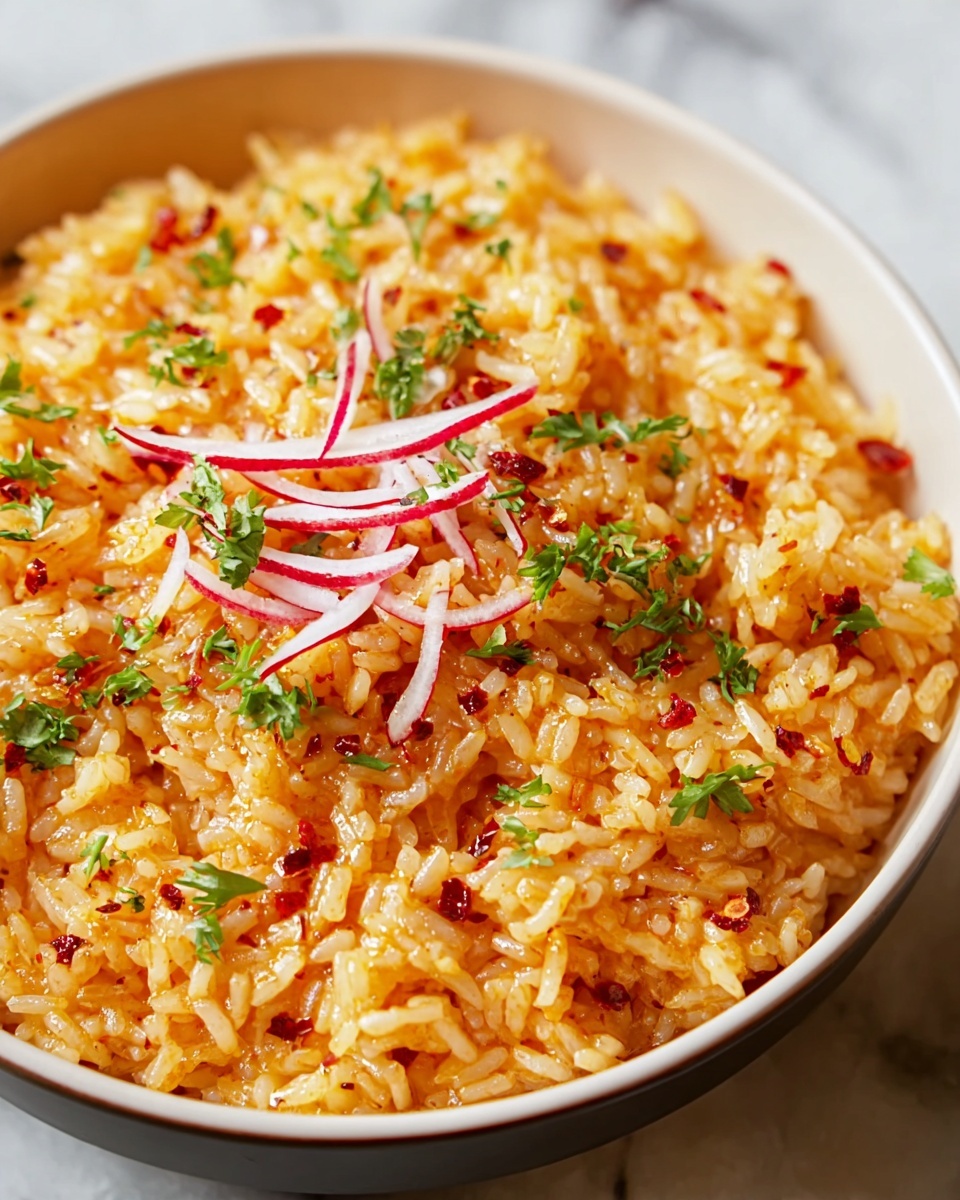
Ingredients You’ll Need
Gathering your ingredients for this recipe is a breeze, and each one plays a crucial role in building layers of flavor, texture, and just the right amount of spice. From the rich cheeses to the fragrant aromatics and the essential Arborio rice, these ingredients come together beautifully to create that perfect risotto experience.
- Olive oil: A simple base to gently sauté your aromatics and bring depth to the dish.
- Small onion, finely chopped: Adds sweetness and a tender bite once cooked down.
- Garlic cloves, minced: Infuses the dish with its warm, irresistible aroma.
- Arborio rice: The superstar grain that absorbs flavors and releases starch to create creamy risotto.
- Dry white wine (optional): Adds a subtle tang and complexity during deglazing.
- Chicken or vegetable broth, warm: Slowly infused into the rice, it carries all the flavors in every spoonful.
- Gochujang: This Korean chili paste brings a delightful blend of heat, sweetness, and umami.
- Grated Parmesan cheese: Adds a salty, nutty richness that enhances every bite.
- Shredded mozzarella cheese: Melts beautifully for that gooey, cheesy goodness.
- Heavy cream (optional): Gives the risotto an extra touch of luscious creaminess.
- Salt and pepper: To taste, perfect for seasoning and balancing flavors.
- Fresh parsley, chopped: A fresh, herbaceous garnish that brightens the final dish.
How to Make Cheesy Gochujang Risotto Recipe
Step 1: Sauté the Aromatics
Start by heating the olive oil in a large skillet over medium heat – this is where the magic begins. Toss in your finely chopped onion and cook gently until it softens and turns translucent, releasing its sweet fragrance. Then add minced garlic and cook for just a minute more, letting that warm, garlicky aroma fill your kitchen. This flavorful base sets the tone for the whole dish.
Step 2: Cook the Rice
Next, stir in the Arborio rice and coat each grain with the aromatic oil mixture. You’ll want to cook the rice for a couple of minutes until it looks slightly translucent around the edges, signaling that it’s ready to soak up all that delicious broth. This is a crucial step to get that creamy texture we all adore in risotto.
Step 3: Deglaze the Pan (Optional)
If you’re feeling fancy, pour in the dry white wine now and give everything a good stir. This adds a subtle acidity and depth, and you should cook it until the wine almost completely evaporates, leaving behind its delicate flavor notes. If you’re skipping the wine, no worries – the broth will do all the heavy lifting.
Step 4: Add the Broth Gradually
This is where the patience pays off. Ladle the warm broth into the rice one bit at a time, stirring constantly. Let the rice absorb each addition before adding more, and continue this cycle for about 18 to 20 minutes. The slow absorption releases the starch from the rice, turning it creamy without any cream needed yet. Keep your stir game strong; it helps build the luscious texture risotto is known for.
Step 5: Stir in Gochujang and Cheeses
Once your rice has reached a creamy, tender stage, stir in the vibrant gochujang with all its spicy, sweet, and umami goodness. Then fold in the Parmesan and mozzarella cheeses, watching as they melt into a velvety blend. For a touch of indulgence, add a splash of heavy cream here if you like. Finally, season with salt and pepper to taste, ensuring every bite is perfectly balanced with a savory kick.
Step 6: Finish and Serve
Take your risotto off the heat, give it one last stir to make sure everything is harmoniously combined, and prepare to impress. Scoop generous portions onto plates or bowls and sprinkle with fresh chopped parsley for a pop of color and freshness. Serve immediately while it’s wonderfully warm and cheesy—this one’s a showstopper!
How to Serve Cheesy Gochujang Risotto Recipe
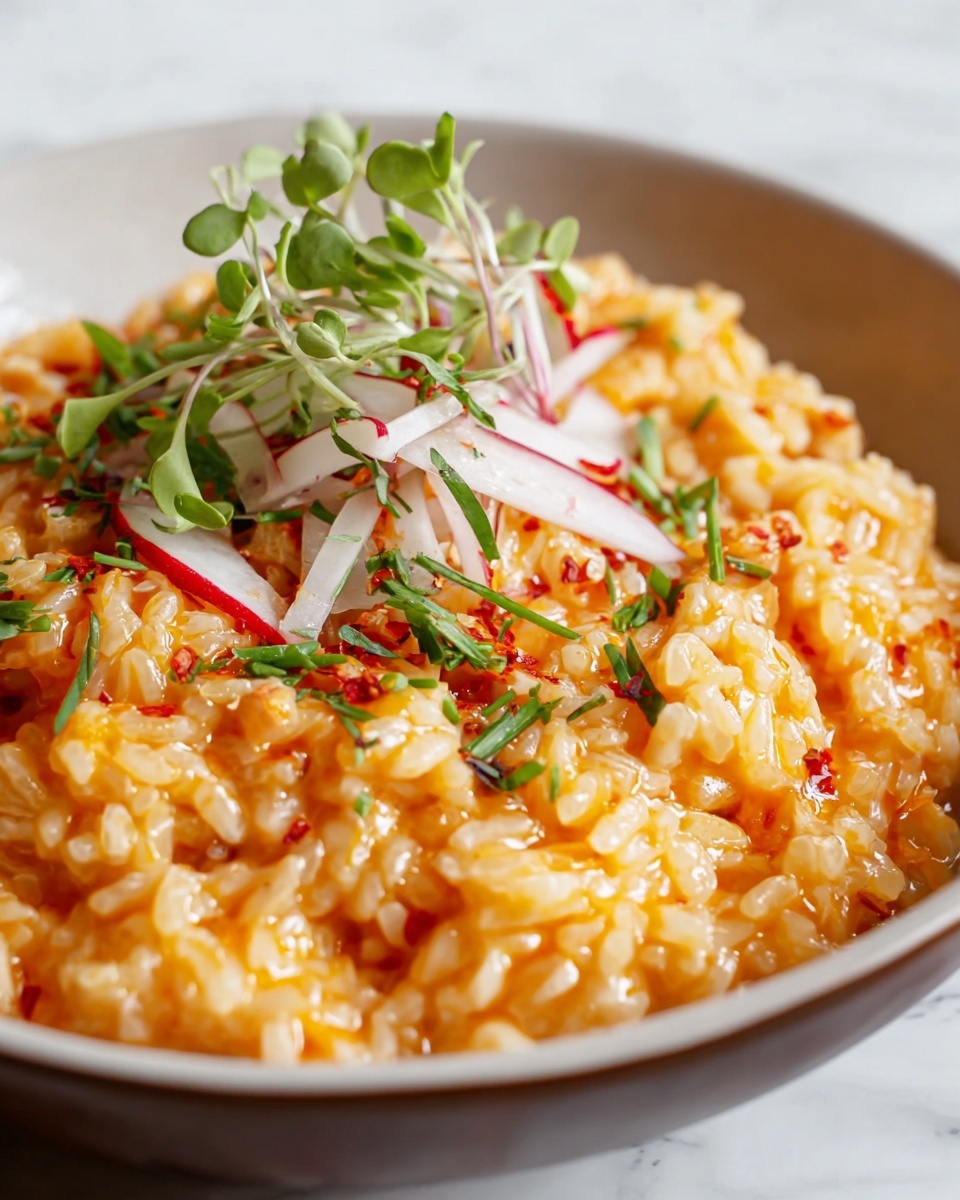
Garnishes
Fresh parsley is a classic finishing touch, but you can also sprinkle toasted sesame seeds or slivers of scallions to add extra texture and a subtle Asian flair. A drizzle of sesame oil or a few flakes of chili pepper can elevate the heat and aroma for those who love a bit more kick.
Side Dishes
This risotto stands beautifully on its own but pairs wonderfully with simple sides. Think crisp green salads dressed lightly with citrus vinaigrette, or roasted vegetables like broccoli or asparagus for a nice contrast in crunch and freshness. A lightly grilled protein like chicken or shrimp can also round out your meal perfectly.
Creative Ways to Present
For a fun twist, try serving the risotto in individual hollowed-out bell peppers or small ramekins, topped with a sprinkle of extra cheese and broiled briefly for a golden crust. Another idea is to use it as a filling for stuffed mushrooms, bringing a playful and elegant element to your meal presentation.
Make Ahead and Storage
Storing Leftovers
If you have leftovers, transfer them to an airtight container and store them in the refrigerator. The risotto will stay fresh for up to 2-3 days, though it’s best enjoyed sooner to keep that creamy texture.
Freezing
Freezing this risotto isn’t ideal because the texture may change once thawed, often becoming a bit grainy. If you must freeze it, do so in small portions for up to one month, but be prepared for a slight difference in creaminess.
Reheating
Reheat gently on the stovetop over low heat, adding a splash of broth or water to loosen it up. Stir frequently until warmed through, restoring the silky consistency. Alternatively, microwave in short bursts, stirring in between, to keep that comforting risotto creaminess alive.
FAQs
Can I make this Cheesy Gochujang Risotto Recipe vegetarian?
Absolutely! Simply use vegetable broth instead of chicken broth, and make sure your cheeses are vegetarian-friendly. The flavor and creaminess will still shine brilliantly.
How spicy is this dish with gochujang?
Gochujang adds a mild to moderate heat with a touch of sweetness. You can easily adjust the amount to suit your spice tolerance, making this recipe friendly for those who want a gentle kick or a bolder punch.
Can I use a different type of rice?
For classic risotto texture, Arborio rice is key because of its starch content. Substituting with regular long-grain rice won’t yield the creamy, luscious texture risotto is famous for.
Is the white wine necessary?
Not at all! The wine adds a subtle depth and complexity, but skipping it won’t compromise the dish. You can simply omit it, and the broth will carry the flavor perfectly.
What can I do if my risotto becomes too thick?
If your risotto thickens too much, just stir in a little warm broth or water to loosen it up. Risotto is best enjoyed creamy and fluid, so don’t hesitate to adjust the consistency before serving.
Final Thoughts
This Cheesy Gochujang Risotto Recipe is such a joy to make and even more delightful to eat. It brilliantly balances comfort food creaminess with exciting, spicy flavors that bring a fresh twist to your typical risotto. I can’t wait for you to try it—you might just find it becoming a beloved staple in your kitchen, perfect for sharing with friends or savoring on your own cozy nights.

